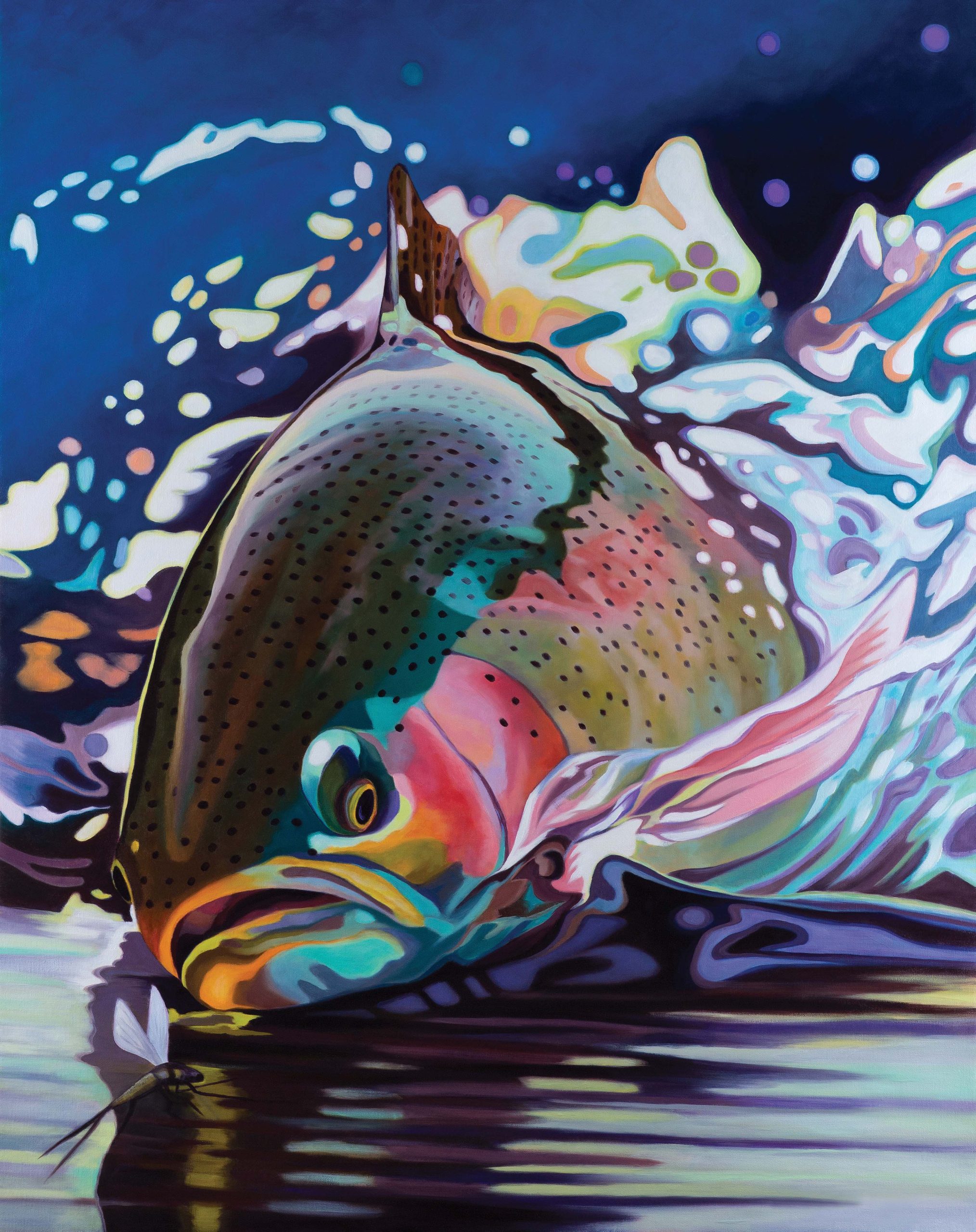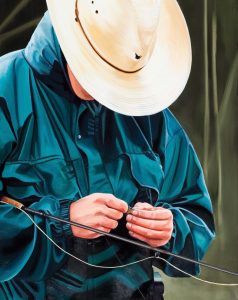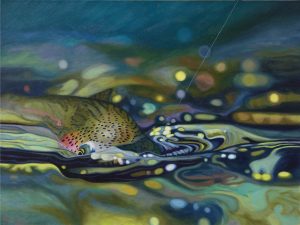
30 Jan Fiction: The Death of a Fish
The old man couldn’t name his favorite place in the world, but the upper canyon of Moose Creek would be close to the top of the list. It is sort of a canyon within a canyon, and hardly anybody ever goes there. The sheer to steep canyon walls and U.S. Forest Service “grizzly country” signs create feelings of confinement and apprehension. The upper canyon meanders for 2 creek miles between high-country trail crossings, the second one at the end of Moose Creek Road. In all the times he had fished there, he had never seen another human, or even human tracks. He always made noise and stayed alert to his surroundings, and, so far, that had been successful. Once, he saw a single, fresh grizzly track in some soft mud, but he never saw the bear and never saw any more signs.
The younger man looked uneasily up the creek into the canyon as the two of them stepped into the swiftly flowing water. He knew how to cast with a fly rod, but, living in Kansas, he had never seen or experienced anything remotely comparable to this. The two men were wet wading, wearing shorts and felt-soled boots with heavy socks as they waded across the stream. The younger man was shocked by the icy water. It was early July, and although the water had cleared, a great deal of it still came from melting snow or ice fields on north-facing slopes and cascaded down shaded drainages to the creek. Still mildly concerned about bears, he remembered what the old man told him at breakfast: “As long as you carry pepper spray, don’t do anything stupid — like messing with their food or cubs — and don’t surprise them, there isn’t much to worry about.”

“And that works?” he had asked.
“It has for me,” the old man replied. “Life doesn’t offer any guarantees, but there are usually things you can do to improve your odds.”
“I’ve got a lot to learn about fishing in this part of the country,” the younger man said, smiling back at his father.
Most of the holes along the creek were small, with room for only one person to fish, so the two men alternated from hole to hole as they moved along. The haphazard piles of rocks and fallen trees, some fresh and some dead and rotten, made passage up the canyon difficult at times, but they climbed carefully, testing each foothold before committing their weight. The fish didn’t hesitate to come to their dry flies, and they took fish from nearly every hole. This creek was no more than 20 feet wide, and many of the fish were small, but most were 10 to 12 inches and two approached 15. They were releasing all the fish, but took time to stop and admire their vivid colors before letting them go.
Shortly after a lunch break, they came to a place in the canyon where boulders, rotten logs, and downed trees made it almost impossible to bushwhack. There was also, however, what was probably the best pool in the canyon to fish. Here, the water level in the creek cascaded down several feet in a very short distance from the pool, above a pile of boulders and stacked logs. The pool was flanked by 30-foot rock faces extending past it, rendering the pool inaccessible from either side or upstream. The logs had limbs reaching skyward, limiting their ability to cast into the pool from the creek level. The only way to get a fly into the water was to cling to the rock wall — making your way over some treacherous-looking rocks about 10 feet up the right-hand side of the canyon, through thick overhanging bushes, to a tiny ledge just before the sheer rock face began — then risk turning loose the handholds in the rocks long enough to make a cast.
“It’s your turn,” the old man said, looking at his son. “Want to give it a try?”
“I don’t think so,” the younger man said, looking up at the ledge and slowly shaking his head. “I’m still new at this, and that looks pretty dicey to me. If you fell off there, the current could pull you under the logs, and the branches could hold you there until you drowned. I think I’ll pass.”
“You sure? This hole looks too good to pass up, so if you don’t try it, I will.”
The young man looked at his father apprehensively. “I really think that’s a bad idea,” he said. “I know you’ve done this sort of thing for a long time, and you’re in good shape, but you have to admit, you’re no spring chicken. I think that spot is too risky.”
The old man smiled back at him.
“Steve, as Jimmy Buffett once wrote, ‘Life doesn’t come without risks. You learn to take them, or you stay home and watch life on TV.’ I’m going to give it a try.”
At the base of the rock wall, and before climbing, he stripped several feet of line off the reel and held it in loops in his left hand, along with the fly rod. Then, he started making his way along the wall, holding onto overhanging bushes with his right hand, testing each one before putting any weight on, using them more for balance than support. He moved slowly, searching for secure footholds until he felt that he was in a position to make a reasonable cast. He dropped the loops of line, made three false casts with his left hand to get the line out, and then managed to drop the fly halfway up the pool. It wasn’t a pretty cast from that position; the fly line hit the water, making a tiny splash. He cursed himself for blowing the cast as he watched the fly start to drag, and he hoped that he hadn’t spooked the pool. He was about to pick the fly up and try another cast when a large rainbow came streaking from the far side of the pool. It slammed the fly and made a sharp left turn, heading upstream.

The old man raised the rod, and the fish jumped, revealing its immense size. He had no way to control the reel, so he just allowed the drag to keep pressure on the fish as it streaked against the current to the head of the pool, jumped the log there, and moved into a shallow riffle just upstream. It struggled there — its back and dorsal fin clearly visible in the thin water — exerting a great deal of energy before giving up and returning to the pool. As it turned, the old man anticipated it coming fast and scurried down the rocks to more stable footing where he could have both hands free to manage the rod and reel while taking in some line.
As he reeled frantically, unable to take in enough line to make it taut, the fish swam for the far bank, jumping again before heading downstream toward the cascade at the tail of the pool. The old man held the rod as high as he could in a vain attempt to turn the fish before it tumbled down the cascade into the run that led to the next pool.
As the old man bounded over a pile of loose, small boulders to get in position to keep up with the fish — still trying to take in line as he moved — the fish swam underneath the protrusion of a boulder wedged against a logjam across the creek, half in the water and half out, and it seemed that all was lost. Surely, the fish would break off now and be gone.
By this time, the fish was swimming with the fast-moving current and taking line again as the old man quickly, but without panic, moved toward the rock, dropped the rod into the water, and released it into the current rushing under the rock. He retrieved it on the other side and continued to follow the fish. While this was happening, the fish made its way through the limbs of a dead, fallen tree in the water and into the deeper, slower water of the next pool. The old man kept the rod bent, and now the line was tight. He calmly and patiently lifted two of the fallen tree’s limbs, freeing the line, and moved to the pool in time to apply pressure and keep the fish out of another fallen tree on the opposite side.
By now, the old man could see the fish well and could tell it was exhausted, just hanging in the water and moving only slightly but still pulling, trying desperately to escape. His son was at his side as he finally dragged the fish over to the sandy edge of the water and held him there.
The younger man quietly looked down at his father, crouched on the edge of the water, holding the fish in his left hand and gently removing the hook from the corner of its mouth. The old man didn’t look up, but now was holding the fish with his hands under its belly and its head facing upstream, moving the fish slowly forward and back in the edge of the current. He was trying to revive the spent fish by letting water flow over its gills, but the fish showed no signs of movement or life.
Then, he said softly, “I’ve never seen a fish fight like that.”
The younger man stood patiently in silence, watching as his father, more intently now, continued moving the fish back and forth. Still, the fish showed no indication of life. This continued for several more minutes, and finally, the younger man could see his father’s movements begin to slow and then stop as reality set in. The fish was dead.
The old man stood up, still holding the fish in his hands, and looked at his son, shaking his head.
“Did you ever see a fish fight like that?” he asked. “I’ve caught a lot of fish, and seen a lot more caught, but I’ve never seen one do things like this one did. He gave it everything he had, and it killed him, but, by God, he wouldn’t give up, right to the end. Look at that fish,” he said, holding it out for the younger man to examine. “Did you ever see a finer fish?”
“No, I haven’t,” he replied, looking down and admiring the fish. “It’s too bad he didn’t survive.”
“Yeah, it is too bad. I’ve seen a lot of big fish here, but this one must have been king of the creek.”
“Let’s measure him,” the young man suggested. “I’d guess that he’s about 20 inches, but I’d like to know for sure.”
The old man laid the fish down on a rock while his son stretched the measuring tape: The fish was just a shade under 19 inches from the tip of its hooked jaw to the fork in its tail.
“Well, he’s not a record,” the old man said, “but he’s damn sure the biggest I ever saw in a little creek like this.”
The old man squatted there, holding the dead fish in the edge of the stream for what seemed like a long time. His son, still standing quietly alongside him, could tell that he was feeling bad about killing it.
“He had to be really old to have grown that big in this little creek,” the young man said, trying to make his father feel better. “There’s a pretty good chance that he wouldn’t have made it through another winter, even if he avoided all the predators all summer.”
“I know. You’re probably right. I just wish I wasn’t the one to end it for him. Sure, I wanted to catch him, but I wanted to admire him and then let him go in the current and watch him swim away. I’ve killed and eaten a lot of fish over the years, but somehow, this one just seems different.”
He held the fish in the current and almost let it go but then had a change of heart. Without a word, he pulled out his Swiss army knife and opened the blade, still holding the fish. As his son silently watched, he turned the fish upside down, inserted the point of the blade in the anus, and made a clean slit along the belly, all the way to the gills. After that, he deftly sliced around each pectoral fin and then passed the blade under the chin from one side to the other, cutting away the thin strip of flesh and cartilage there. Placing a finger on either side of the gills and pinching with the thumb, he pulled out gills, guts, and all, dropping them into the current. He almost kept the heart and liver but thought better of it and let them go, too. He picked up the knife and ran the blade along the inside of the spine, slitting the membrane there and removing the dark strip of kidney matter. He dipped the fish in the water, washing away the residue, and he was done. He opened his backpack, put the cleaned fish in the plastic bag that had held his lunch, picked up his fly rod, and headed up the creek.
The two men climbed carefully in silence up the steep 30-foot embankment to get around the cliff face at the hole. When they were finally back on the creek bed and had begun walking upstream, the young man said casually, “I thought this was a catch-and-release stream.”
“It is.”
“I read somewhere that if you accidentally kill a fish on one of these streams, you’re supposed to put it back in the stream for the animals and birds that feed on fish.”
“You are,” the old man said as they walked across a gravel bar and started to climb over a large spruce that had fallen across the creek, blocking the canyon from side to side. “But look down under your feet and remember all the logjams and rock piles that we’ve climbed over today. Maybe I should have put this fish back in the creek and, if I had, maybe it would have been eaten by an animal or a bird and, if so, that would have been fine. But, more likely, it would have washed up under one of these piles of logs, someplace inaccessible, and gone to rot and waste. Somehow, I think this fish deserves better than that.”
Charley Hester enjoyed fly fishing the Yellowstone area for 21 years, mostly on the small streams and high lakes of the Madison Valley. His stories have appeared in Big Sky Journal, Outside Bozeman, and SAIL magazines. Also a sailor, his book, Sailing With Strangers, documents his circumnavigation of South America on a 46-foot sailboat.
Painting from the age of 6, A.D. Maddox started her professional career in Jackson Hole, Wyoming in the 1990s painting popular wildlife and fly-fishing art. Currently, Maddox is creating the Secluded Water Series, her most technical work of trout to date. AD Maddox Studios, located in downtown Livingston, Montana, is a working studio displaying her original oils; admaddox.com.




No Comments